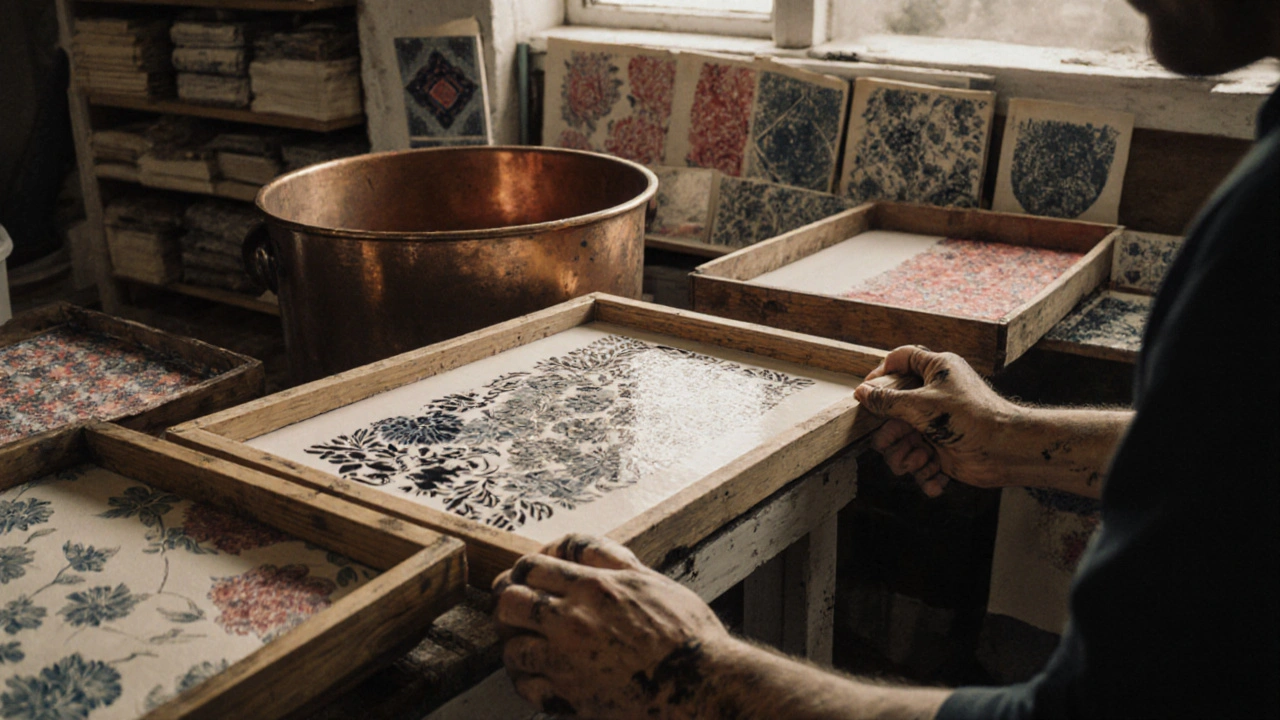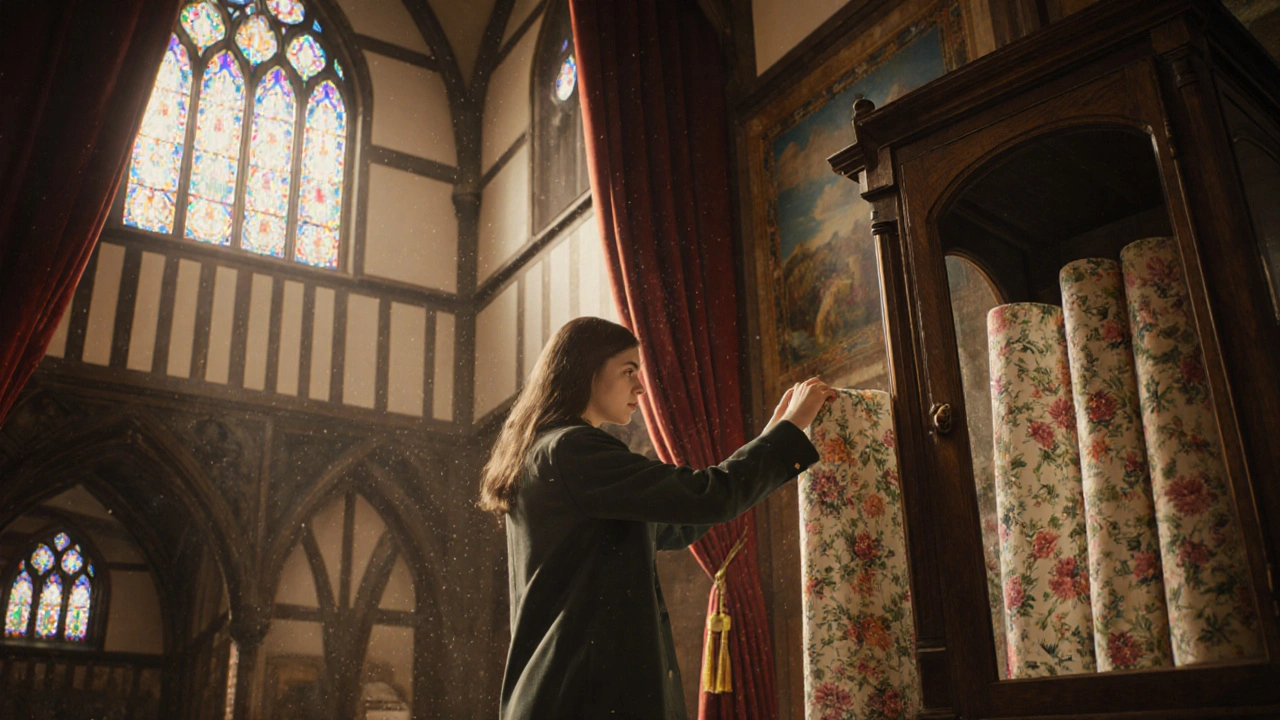Walk into Liberty London and you’re not stepping into a typical department store. You’re walking into a living museum of design, where oak beams stretch overhead, stained glass glows beside velvet drapes, and every corner feels like a scene from a 16th-century English manor-except the clothes are from this year, and the prices are very much 2025.
Why Liberty London Feels Like a Time Machine
Liberty London opened in 1875, but its iconic Tudor-style façade wasn’t built until 1924. The building itself is a Grade II listed structure, meaning it’s legally protected for its historical and architectural value. The half-timbered exterior, with its dark wooden beams and white plaster, was inspired by Elizabethan architecture. Inside, the atrium is lined with hand-painted murals, and the staircases curve like something out of a Shakespearean play. This isn’t just decoration-it’s part of the brand’s DNA.Unlike other department stores that chase sleek minimalism, Liberty doubled down on heritage. The result? A space that feels more like a curated art gallery than a retail floor. You’ll find antique-looking display cases holding modern handbags, and velvet-lined drawers revealing silk scarves printed with 1890s floral patterns-reissued today by Liberty’s in-house design team.
The Fabric That Changed Fashion
Liberty’s most enduring legacy isn’t the building-it’s the fabric. In the 1870s, Arthur Lasenby Liberty started importing hand-blocked silks and cottons from India and Japan. He didn’t just sell them; he transformed them. His designers reworked traditional Asian motifs into swirling, Art Nouveau-inspired prints that became wildly popular in Europe.By 1900, ‘Liberty prints’ were a global phenomenon. Artists like William Morris and Charles Rennie Mackintosh used them in their work. Today, Liberty still produces over 1,200 fabric designs annually, many of them hand-printed in their own mill in the UK. The famous ‘Tana Lawn’ cotton-so fine it feels like silk-is still made from Egyptian-grown cotton and dyed using proprietary techniques. It’s used by fashion houses like Alexander McQueen and Dior for high-end garments, but you can buy a yard of it here for £18.
Designer Collections You Won’t Find Elsewhere
Liberty doesn’t just sell big-name brands. It curates. On the upper floors, you’ll find a mix of emerging British designers and cult international labels that don’t have physical stores in London. Think: Liberty London’s exclusive capsule collections from designers like Rixo, E.L.V. Denim, and House of Sunny-all available nowhere else in the UK.The beauty section is equally unique. Brands like Lush, Aesop, and The Ordinary sit beside tiny British apothecaries like Pothecary and L’Occitane’s limited-edition Liberty collaborations. Their seasonal scents-like ‘Autumnal Woods’ or ‘Crimson Rose’-sell out within days.
For jewelry, Liberty’s in-house collection features hand-finished pieces with semi-precious stones and engraved motifs pulled from their archive of 19th-century patterns. You won’t find these on Net-a-Porter or Farfetch. They’re only here.

How Liberty Stays Relevant in 2025
You might wonder: in a world of Amazon and fast fashion, how does a 150-year-old store with hand-printed fabrics and oak staircases stay alive?It’s not luck. It’s strategy. Liberty doesn’t compete on price. It competes on story. Every item comes with a label explaining its origin-where the cotton was grown, who printed the design, how many hours went into stitching it. They publish an annual ‘Crafted in Britain’ report showing exactly where each product was made.
They also invest heavily in sustainability. Since 2022, 87% of their fabrics are certified by GOTS (Global Organic Textile Standard). Their packaging is 100% plastic-free, using recycled paper and soy-based inks. Even their shopping bags are made from upcycled Liberty fabric remnants.
And they’ve embraced digital without losing soul. Their app lets you scan a garment and see its full lifecycle: from seed to shelf. Their in-store digital kiosks show short films of the artisans who make their prints. You can’t buy a shirt here without knowing who made it.
What to Buy (and What to Skip)
If you’re visiting Liberty London, here’s what actually delivers value:- Buy: Tana Lawn fabric by the yard (great for sewing, quilting, or even framing as art)
- Buy: Limited-edition scarves from their seasonal designer collabs
- Buy: Their own-brand candles and room sprays-scented with natural oils, not synthetic fragrances
- Buy: The Liberty London tote bag-it’s made from recycled cotton and printed with their classic 1920s floral
- Skip: Mass-market branded handbags. They’re overpriced compared to Selfridges or Harrods
- Skip: Generic skincare from big names. Their own apothecary line is better and cheaper

Why It’s More Than a Store
Liberty London isn’t just a place to shop. It’s a cultural landmark. It’s where designers go to find inspiration. Where tourists take photos because it looks like a movie set. Where locals come to buy fabric for their wedding dresses or to gift a scarf to a friend who appreciates craft.It’s one of the few places in London where you can walk in, spend an hour wandering without pressure, and leave with something that feels meaningful-not just bought.
On a rainy afternoon in November, the light filters through the stained glass, catching dust motes in the air. Someone’s humming. A child touches a silk scarf, then looks up at their parent like they’ve just discovered magic. That’s Liberty. It doesn’t sell products. It sells moments.
Is Liberty London worth visiting if I’m not into fashion?
Absolutely. Even if you don’t buy anything, the building itself is a work of art. The architecture, the stained glass, the hand-painted ceilings-it’s like walking through a museum designed by William Morris. Many visitors come just to photograph the interiors, sip tea in the Liberty Tea Room, or browse the art books in the library corner.
Are Liberty prints still made in the UK?
Yes. Liberty’s fabric printing is done at their own facility in Surrey, using traditional screen-printing methods. Over 80% of their designs are printed on-site. Each print can take up to 12 hours to complete, with up to 16 colors layered by hand. This is why Liberty fabric costs more than mass-produced prints-it’s made by skilled artisans, not machines.
Does Liberty London have sales?
Yes, but they’re limited. Liberty holds two major sales a year: one in January and one in July. They don’t do Black Friday or seasonal markdowns like other stores. Their sales focus on end-of-season stock, overstocked fabrics, and discontinued designs. The best deals are on Tana Lawn remnants and scarves-sometimes 50% off.
Can I buy Liberty fabric online?
Yes. Liberty’s website lets you buy fabric by the meter, with free UK delivery on orders over £50. They also sell pre-cut kits for quilts, pillow covers, and bags. International shipping is available, but customs fees may apply. Many international customers order fabric to make their own clothing or home décor.
Is Liberty London crowded?
It gets busy on weekends and holidays, especially during the Christmas season. The best time to visit is Tuesday or Wednesday morning, right after opening. The store opens at 10 a.m., and by 11 a.m., the crowds start rolling in. If you want quiet time to browse the fabrics or take photos without people in the frame, go early.
What Comes Next
Liberty London is planning a major expansion of its design studio in 2026, where they’ll train a new generation of textile printers. They’re also launching a digital archive-free to the public-of every print they’ve ever made since 1875. You’ll be able to search by color, era, or pattern type, and even download patterns for personal use.For now, the store remains a quiet rebellion against homogenized retail. It’s proof that heritage, craft, and intention can still thrive in a world obsessed with speed and scale.
